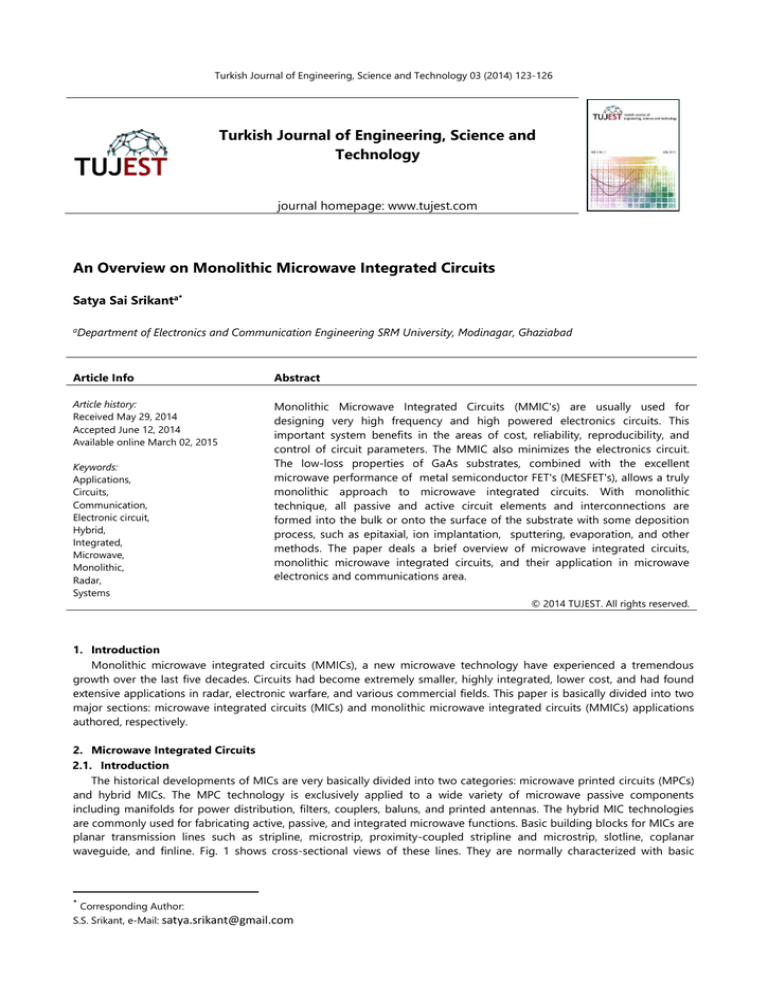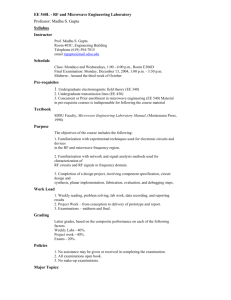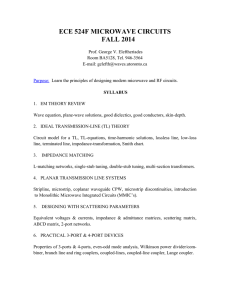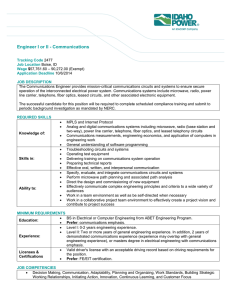
Turkish Journal of Engineering, Science and Technology 03 (2014) 123-126
Turkish Journal of Engineering, Science and
Technology
journal homepage: www.tujest.com
An Overview on Monolithic Microwave Integrated Circuits
Satya Sai Srikanta*
aDepartment
of Electronics and Communication Engineering SRM University, Modinagar, Ghaziabad
Article Info
Abstract
Article history:
Received May 29, 2014
Accepted June 12, 2014
Available online March 02, 2015
Monolithic Microwave Integrated Circuits (MMIC's) are usually used for
designing very high frequency and high powered electronics circuits. This
important system benefits in the areas of cost, reliability, reproducibility, and
control of circuit parameters. The MMIC also minimizes the electronics circuit.
The low-loss properties of GaAs substrates, combined with the excellent
microwave performance of metal semiconductor FET's (MESFET's), allows a truly
monolithic approach to microwave integrated circuits. With monolithic
technique, all passive and active circuit elements and interconnections are
formed into the bulk or onto the surface of the substrate with some deposition
process, such as epitaxial, ion implantation, sputtering, evaporation, and other
methods. The paper deals a brief overview of microwave integrated circuits,
monolithic microwave integrated circuits, and their application in microwave
electronics and communications area.
Keywords:
Applications,
Circuits,
Communication,
Electronic circuit,
Hybrid,
Integrated,
Microwave,
Monolithic,
Radar,
Systems
© 2014 TUJEST. All rights reserved.
1. Introduction
Monolithic microwave integrated circuits (MMICs), a new microwave technology have experienced a tremendous
growth over the last five decades. Circuits had become extremely smaller, highly integrated, lower cost, and had found
extensive applications in radar, electronic warfare, and various commercial fields. This paper is basically divided into two
major sections: microwave integrated circuits (MICs) and monolithic microwave integrated circuits (MMICs) applications
authored, respectively.
2. Microwave Integrated Circuits
2.1. Introduction
The historical developments of MICs are very basically divided into two categories: microwave printed circuits (MPCs)
and hybrid MICs. The MPC technology is exclusively applied to a wide variety of microwave passive components
including manifolds for power distribution, filters, couplers, baluns, and printed antennas. The hybrid MIC technologies
are commonly used for fabricating active, passive, and integrated microwave functions. Basic building blocks for MICs are
planar transmission lines such as stripline, microstrip, proximity-coupled stripline and microstrip, slotline, coplanar
waveguide, and finline. Fig. 1 shows cross-sectional views of these lines. They are normally characterized with basic
*
Corresponding Author:
S.S. Srikant, e-Mail: satya.srikant@gmail.com
S.S. Srikant/ Turkish Journal of Engineering, Science and Technology 03 (2014) p123-126
124
parameters, i.e., characteristic impedance, phase velocity, effective dielectric constant, attenuation constant, and powerhandling capability.
Figure 1. Planar transmission lines for MIC : (a) Stripline (b)Microstrip (c)Coupled
microstrip (d)Slotline (e)Coplanar waveguide (f) Finline
The parameters are evaluated in terms of their cross-sectional dimensions, properties of the dielectric substrates, and
the conductor materials used.
2.2. Microwave Printed Circuits
The stripline is the basic building block for Microwave Printed Circuits (MPCs) [1]–[3]. The principle on stripline was
first reported in 1951 [4], and papers on theoretical design information were published on the basis of characteristic
impedance, junction discontinuities, and coupled striplines. The researchers published number of research papers
describing the theory, design, fabrication, and measured data for the TEM-line edge-coupled directional couplers. Among
stripline components, directional couplers are the most popular. These couplers can provide coupling in the 8–40-dB
range.
Most of the applications such as, a tight coupler such as a 3-dB coupler is required and is difficult to realize as the
very tight spacings needed are limited by current photo-etch techniques. This problem was solved by using threedielectric layer broadside coupled striplines [5] and offset broadside coupled striplines [6] and led to the development of
tight stripline couplers. Narrow-band couplers can also be realized using the branch-line configuration.
The most popular configurations for TEM stripline filters are low–high impedance low-pass filters, and end-coupled,
hairpin-line, parallel-coupled, interdigital, and comb line bandpass filters. Stripline bandpass filters are widely used in
microwave systems.
The early work on stripline served as the seeds for the successful growth of MPCs and the introduction of hybrid
MICs. Over the past three decades, MPC technology is steadily improving in the areas of new materials, high-resolution
etching, milling circuit patterns, accurate modeling, automatic manufacturing, and cost effectiveness.
2.3. Hybrid Microwave Integrated Circuits
Microwave applications with high volume are either served by hybrid Microwave Integrated Circuits (MICs) or
Monolithic Microwave Integrated Circuits (MMICs) or both used together. Traditionally, in MICs, active and passive
discrete components such as transistors, inductors, capacitors, and resistors are attached externally to an etched circuit
on alumina (the most common microwave ceramic) or some soft substrate. The etched alumina or soft substrate may also
have other distributed passive components such as filters, couplers, and combiners. In such circuits, sections of planar
transmission lines are the basic building blocks.
The evaluation of hybrid MICs began in 1955 when the microstrip line was introduced. Till now, a lot of numerous
papers were published on microstrip-line characteristics including characteristic impedance, phase velocity and
dispersion, losses, junction discontinuities, coupled microstrip lines, microstrip antennas, and other planar lines.
Major evolutionary events included Wheeler’s paper on microstrip line characteristics [7], accurate data for coupled
lines using a variety of substrate materials, introduction of lumped elements for microwave circuits, microstrip compatible
3-dB Lange coupler, and several new MIC lines, e.g., slotline, coplanar waveguide, and finline for millimeter-wave
applications. Fig. 2 shows microstrip configurations for a 3-dB Lange coupler and a two-way divider. The growth of MIC
technology took off after the development of techniques for printing microwave circuits on alumina substrates and the
availability of GaAs FETs.
S.S. Srikant/ Turkish Journal of Engineering, Science and Technology 03 (2014) p123-126
125
Thus MICs brought about a revolution in the microwave industry because so many microwave functions could be
packaged into a small space and batch fabricated for large volume production.
Figure 2. (a) 3- dB Lange microstrip coupler. (b) Two-way Wilkinson microstrip divider.
During the past five decades, MIC technology has played a key role in the growth of microwave applications in the
areas of modeling, automatic manufacturing, multilayer production, and cost effectiveness.
3. Monolithic Microwave Integrated Circuits
The past four decades has witnessed the emergence of scientific and engineering developments relevant to the
growth of the microwave field. Much of this earlier work was related to government-sponsored activities pertaining to
military applications, and to research conducted in several industrial and university laboratories[8]. Monolithic microwave
integrated circuits (MMICs), a new microwave technology which is expected to exert a profound influence on microwave
circuit designs for future military systems as well as for the commercial and consumer markets. So “A monolithic
microwave integrated circuit (MMIC) is an active or passive microwave circuit formed in situ on a semiconductor
substrate by a combination of deposition techniques including diffusion, evaporation, epitaxy, and other means.”
Monolithic microwave integrated circuits based on silicon-on-sapphire (SOS) and gallium arsenide technologies are
being considered seriously as viable candidates for satellite communication systems, airborne radar, and other
applications. The low-loss properties of sapphire and semi-insulating GaAs substrates, combined with the excellent
microwave performance of metal-semiconductor FET's (MESFET's), allows, for the first time, a truly monolithic approach
to microwave integrated circuits.
The MMIC technology fulfils the following objectives:
1. Cost reduction by batch processing;
2. Higher reliability and improved reproducibility;
3. Size and weight reduction;
4. Circuit design flexibility and multifunction performance;
5. Multi-octave operation.
In particular, the first four objectives were attained for the same reasons that digital computer circuits have achieved
them. The fifth objective follows from the compact circuit configurations possible, which minimize bandwidth- limiting
parasitic capacitances and inductances, and from the confinement of electromagnetic fields within the semiconductor
substrate. A more about MMIC along with design consideration was broadly discussed by Pucel [9-10].
4. Conclusions
The last five decades have been witness to the development and growth of an entirely new and exciting microwave
field related to MIC and MMIC. The initial requirement for this development was a response to the needs of new military
systems and then to commercial field. This microwave field is still expanding at a rapid rate, though now promoted by a
variety of commercial applications including the new demands of the Information Age with its emphasis on high-speed
and large-bandwidth requirements.
Acknowledgment
The author is thankful to scientists and faculty members who helped and encouraged me to publish research papers.
S.S. Srikant/ Turkish Journal of Engineering, Science and Technology 03 (2014) p123-126
126
References
[1] R. M. Barrett, “Microwave printed circuits—The early years,” IEEE Trans. Microwave Theory Tech., vol.-32, Sept. 1984,
pp. 983–990,
[2] H. Howe, Jr., “Microwave integrated circuits—An historical perspective,” IEEE Trans. Microwave Theory Tech., vol-32,
Sept. 1984, pp. 991–995.
[3] A. A. Oliner, “Historical perspectives of microwave field theory,” IEEE Trans. Microwave Theory Tech., vol.-32, Sept.
1984, pp. 1022–1045.
[4] R. M. Barrett and M. H. Barnes, “Microwave printed circuits,” Radio Telev., vol. 46, Sept. 1951, pp. 16
[5] C. P. Tresselt, “The design and construction of broadband, high directivity, 90-degree couplers, using nonuniform line
techniques,” IEEE Trans. Microwave Theory Tech., vol. MTT 14, Dec. 1966, pp. 647–657.
[6] J. P. Shelton and J. A. Mosko, “Synthesis and design of wide-band equalripple TEM directional couplers and fixed
phase shifters,” IEEE Trans. Microwave Theory Tech., vol. MTT-14, Oct. 1966, pp. 462–473.
[7] H. A. Wheeler, “Transmission line properties of a stripline between parallel planes,” IEEE Trans. Microwave Theory
Tech., vol. MTT-26, Nov. 1978, 866–876.
[8] L. N. Ridenour, Ed., Radiation Laboratory Series. New York: Mc- Graw-Hill, 1948, pp. 1–28.
[9] R. A. Pucel, “Design considerations for monolithic microwave circuits,” IEEE Trans. Microwave Theory Tech., vol. MTT29, pp. 513–534, June 1981.
[10] R. A. Pucel, Ed., Monolithic Microwave Integrated Circuits. New York: IEEE Press, 1985.





